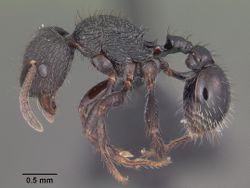Key to Pogonomyrmex of Hispaniola
These keys are based on: Johnson, R. A. and S. P. Cover. 2015. A taxonomic revision of the seed-harvester ant genus Pogonomyrmex (Hymenoptera: Formicidae) on Hispaniola. 2015. 3972:19. doi:10.11646/zootaxa.3972.2.5
Johnson and Cover (2015) recently revised the Hispaniola species of this genus. Their comments in regards to the genus and the species that occur here:
Recent collections provided material to re-evaluate species boundaries and to update information on taxonomic status, distribution, biogeography, and biology for the Pogonomyrmex of Hispaniola so as to make this interesting group more accessible for future studies. Unresolved problems include determining microhabitat preferences, dietary preferences, and foraging strategies of all three species. Males are presently unknown in Pogonomyrmex schmitti and Pogonomyrmex aterrimus, and additional collections are needed to verify the taxonomic status of “P. darlingtoni”.
Colony founding behavior promises to be a rewarding subject to investigate given the very small size of queens for P. schmitti and Pogonomyrmex saucius. Based on our morphological data, P. schmitti probably has the lowest queen to worker mass dimorphism (for species with alate queens) within the genus. Previously, the lowest queen to worker mass ratio occurred in Pogonomyrmex pima (queen dry mass/worker dry mass = 2.05), in which alate queens are significantly larger than workers (Johnson et al. 2007; R.A. Johnson, unpub. data). Queens of P. saucius were also small as their HW and HL fell within the range of measured workers, but their pronotal width was greater than that of all measured workers. The small size of these queens suggests that colony founding occurs via queen foraging, pleometrosis, or budding.
At this time, all three Hispaniola species of Pogonomymex are known to have only alate queens, which is interesting given that closely related Ephebomyrmex clade species in North America (P. pima, Pogonomyrmex imberbiculus) (Heinze et al. 1992; Johnson et al. 2007) and South America (Pogonomyrmex naegelii, Pogonomyrmex cunicularius, Pogonomyrmex pencosensis, Pogonomyrmex serpens, and two undescribed species in the P. brevibarbis-group) (Johnson 2015; R.A. Johnson, unpub. data) have ergatoid (wingless) or dimorphic queens (ergatoid and winged). However, we note that few Pogonomyrmex queens have been collected on Hispaniola (1 for aterrimus, 1 for saucius, 4 for schmitti), leaving open the possibility that additional queen phenotypes remain to be collected.
Lastly, we note that all three species of Pogonomyrmex are endemic to and contribute to the high level of endemism for the ants of Hispaniola. Approximately 52% (64 of 124 species) of the native ant species are endemic to Hispaniola (Perez-Gelabert 2008), which is higher than the 36.9% rate for all insects (Perez-Gelabert 2008). Interestingly, species of Pogonomyrmex are absent from other parts of the Greater Antilles (i.e., Cuba, Puerto Rico, Jamaica, and the Cayman Islands) (Fontenla 1997; Reyes 2002) and all islands in the Lesser Antilles.
You may also be interested in
- Pogonomyrmex
- Hispaniola species list
- The Ants of Hispaniola
Key to Workers
1
- Dorsum and sides of mesosoma and posterior surface of petiolar node with coarse, regular to weakly irregular, subparallel, longitudinal rugae . . . . . Pogonomyrmex saucius
- Dorsum and sides of mesosoma rugoreticulate to vermiculate; posterior surface of petiolar node mostly smooth, granulate-punctate to rugoreticulate, but lacking subparallel longitudinal rugae . . . . . 2
2
return to couplet #1
- Small (HW = 0.90–1.17 mm); posterior surface of petiolar node viewed from behind and above broadly fan-shaped and about as wide as long; in dorsal view, petiolar node about as wide as postpetiolar node (PW/PPW = 0.87–1.03); anterior surface of petiolar node mostly smooth and shining, forming a noticeably obtuse angle with peduncle of petiole; dorsum of postpetiole and first gastral tergum smooth and shining to partly or completely punctate, weakly shining . . . . . Pogonomyrmex schmitti
- Larger (HW = 1.11–1.35); posterior surface of petiolar node viewed from behind and above elongate, clearly longer than wide; in dorsal view, petiolar node notably narrower than postpetiolar node (PW/PPW = 0.78–0.90); anterior surface of petiolar node partly to completely sculptured, dull to weakly shining, forming a right to weakly obtuse angle with peduncle of petiole; dorsum of postpetiolar and first gastral tergum strongly punctate, dull . . . . . Pogonomyrmex aterrimus
Key to queens
Q1
- Dorsum of mesocutum, mesoscutellum, and posterior surface of petiolar node with coarse, regular to weakly irregular, subparallel, longitudinal rugae . . . . . Pogonomyrmex saucius
- Dorsum of mesoscutum and mesoscutellum with irregular longitudinal rugae to rugoreticulate/vermiculate; posterior surface of petiolar node mostly smooth, granulate-punctate to rugoreticulate, but lacking subparallel longitudinal rugae . . . . . Q2
Q2
return to couplet #Q1
- Larger (HW = 1.32 mm), notably larger than conspecific workers; in dorsal view, petiolar node elongate (width/length < 0.85), relatively narrow compared to postpetiole (PW/PPW < 0.75); anterior surface of petiolar node moderately sculptured; dorsum of postpetiole and most of first gastral tergum strongly granulate-punctate, dull . . . . . Pogonomyrmex aterrimus
- Smaller (HW = 0.87–1.19 mm), about the same size as conspecific workers; in dorsal view, petiolar node fan-shaped, relatively broad (width/length > 0.90), relatively broad compared to postpetiole (PW/PPW > 0.80); anterior surface of petiolar node largely smooth and shining; dorsum of postpetiole and first gastral tergum smooth and shining to completely punctate, weakly shining . . . . . Pogonomyrmex schmitti












